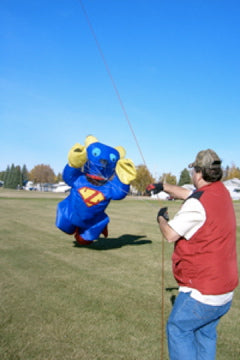Enjoy Kites Safely
 Kites have been flown and enjoyed around the world for centuries. It can be a wonderful and exciting activity. Like most activities, kite flying is not without its risks. We encourage all of our customers to fly safely, responsibly and respectfully. You can do this by reading and following the set-up, flight / operational instructions, as well as any warnings and safety considerations. Doing so will go a long way to ensuring that you enjoy your kite flying experience.
Kites have been flown and enjoyed around the world for centuries. It can be a wonderful and exciting activity. Like most activities, kite flying is not without its risks. We encourage all of our customers to fly safely, responsibly and respectfully. You can do this by reading and following the set-up, flight / operational instructions, as well as any warnings and safety considerations. Doing so will go a long way to ensuring that you enjoy your kite flying experience.
Here are some fundamental Safety considerations for kite flying:
Beware of Power lines. Never fly your kite near power lines!
If you get your kite caught in a power line, DON'T TOUCH THE LINES OR THE KITE! If your kite does get stuck in a power line, immediately let go of the lines and handles and move away. Call your local utility company and tell them what has happened and then secure the area to ensure passers by don't come in contact with the kite or line.
Never fly in Storms! Flying a kite in stormy weather makes YOU a lightning rod, and you could be struck by lightning.
It's not a good idea to use metallic flying line.
Always be aware of your surroundings and aware of others sharing the space. Be considerate of others as everybody has the right to enjoy public spaces just as much as kite flyers do. Be aware of other potential hazard, holes, park benches/structures and the terrain. Be aware of livestock, etc. Some animals are frightened by kites.
Do not fly your kite near or over people. Some kites can travel quite quickly and could hurt someone who is hit by the kite or the lines. Even slower moving power kites can hurt others. Kites can put a lot of tension on the kite lines and can cause severe cuts, bruises, and burns if it comes into contact with anyone at any speed. Remember, spectators may not understand this and may not know there is potential danger, especially young children. It's a good idea to ask spectators to stand behind you when your kite is being flown.

Always use extreme caution when flying large kites. It is a good idea to wear gloves when handling large kites. Use suitable line and solid anchors. Never leave big kites unattended. Be aware that winds can change direction and intensity very quickly.
Sport & power kites need to be flown with particular care. Make sure your kite will not self-launch when setting up (a kite stake can be a valuable safety tool). Follow all safety rules and instructions for the type of sport or power kite you are flying. If a kite you plan to fly did not come with safety instructions, make sure you acquire the proper knowledge to safely control the kite.
Periodically inspect your kite for broken spars or other damage and verify that the bridle and flying lines are not frayed or worn. Do not leave your kite lines unattended while staked or lying on the ground. You do not want people to trip over your kite lines.
Fastening yourself to your kite line can lead to painful, serious injuries. Extra caution must be used if using a harness when traction or power kite flying. We do not recommend a harness for beginners unless they are being trained by and under the supervision of a competent instructor. A harness should never be used without the appropriate quick release. A harness should not be used if there is any doubt that total control of the kite can be maintained.
Big kites can be fun, but it is not safe to fly a kite too large for the current wind  conditions.
conditions.
Keep your flying field clean! Sometimes we may break a line and it is important that this line gets wrapped up and either disposed of in a garbage can or packed away in your kite bag to be reused. Discarded line can be hazardous to other users in the park as well as birds and animals.
Being respectful , safe and good stewards of the flying fields/parks help to make kite flyers welcome users!
Adapted from the Kite Safety developed by "A Wind of Change."
